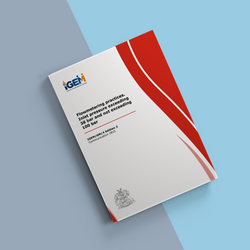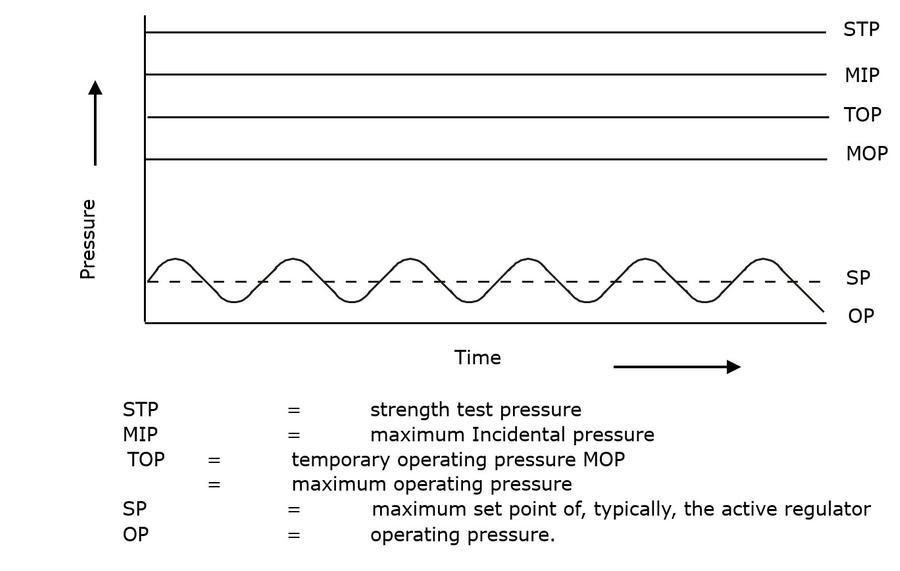IGEM/GM/4 Edition 3 - Flow metering practices. Inlet pressure exceeding 38 bar and not exceeding 100 bar

These procedures gives guidance on the specification, design, installation and operation of meter installations for high accuracy flow measurement of piped Natural Gas operating within the pressure range exceeding 38 bar and not exceeding 100 bar. They cover orifice meters, turbine meters and ultrasonic meters. They only apply to installations supplied with Natural Gas, Liquefied Natural Gas and Simulated Natural Gas in the gaseous phase where the gas temperatures at the meter are between -20 o C and 75 o C.
It includes details of:
- Legal and allied considerations
- Design of the meter systems
- Electrical safety concerns
- Calibration and testing of the metering systems
- Sampling and analysis of the gas in order to calculate gas properties relevant to metering
- The use of secondary instrumentation (including computation)
- Operation and maintenance of the meters.
Introduction
1.1 This Standard is intended to establish a basis of methods and practices for large volume flow meter installations operating on Natural Gas (NG), NG blended with hydrogen and hydrogen systems within a pressure range exceeding 38 bar and not exceeding 100 bar and which have nominal meter tube diameters of 50 mm and above.
1.2 This Standard has been drafted by a Panel appointed by the Institution of Gas Engineers and Managers’ (IGEM’s) Gas Measurement Committee, subsequently approved by that Committee and published by the authority of the Council of the Institution.
1.3 This Standard covers similar subject matter to IGE/GM/4 Edition 2,
Communication 1719, which is obsolete, but now includes additional, enhanced requirements and revisions necessary to align with the Meter Asset Manager Code of Practice (MAMCoP) published by the Supply Point Administration Agreement Ltd (SPAA).
1.4 This Standard embraces the overall design of meter installations that use an orifice plate, turbine meter or ultrasonic meter (USM) as the primary measuring device.
1.5 Sections are included in this Standard covering the secondary instrumentation and other equipment which is necessary to compute mass, volume or energy flow passing through the meter.
1.6 Sections are also included which deal with those factors in the commissioning, operation, maintenance of meter installations and audit of such installations, which are necessary and important to ensure that the measurement performance of the system is sustained over its working life.
1.7 Installations covered by this Standard may come under the regulatory regime of the Oil and Gas Authority or Ofgem within the UK.
1.8 Terms, such as “maximum operating pressure” (MOP), “maximum incidental pressure” (MIP) and “operating pressure” (OP) are to reflect gas pressure terminology used in European Standards. These terms arise in all relevant IGEM technical publications and, possibly, in other standards. Other terms have been included to assist in recognition of design information to be transferred between interested parties.
Referring to Figure 1, note how OP is shown to oscillate about the set point (SP). Note also that MOP can be declared at a higher value than OP. The strength test pressure (STP) has to exceed MIP. This means that, at least with respect to integrity, the meter installation will withstand a fault pressure from the upstream system.
Note: Appendix 13 of IGEM/GM/8 Part 1 shows details of these and other new pressure terms and explains them in more depth.

FIGURE 1 - OPERATIONAL PRESSURE LIMITS
1.9 This Standard makes use of the terms “must”, “shall” and “should” when prescribing particular requirements. Notwithstanding clause 1.14:
- the term “must” identifies a requirement by law in Great Britain (GB) at the time of publication
- the term “shall” prescribes a procedure which, it is intended, will be complied with in full and without deviation
- the term “should” prescribes a procedure which, it is intended, will be complied with unless, after prior consideration, deviation is considered to be acceptable.
Such terms may have different meanings when used in Legislation, or Health and Safety Executive (HSE) Approved Codes of Practice (ACoPs) or guidance, and reference needs to be made to such statutory Legislation or official guidance for information on legal obligations.
1.10 The fundamental considerations in selecting metering elements with regard to meter system performance are the suitability of the type chosen for the nature of the load and the ability of the meter size chosen to give a sufficiently high degree of integrated low uncertainty consistent with the measurement that is being carried out.
1.11 This Standard stipulates requirements of good practice, but compliance does not confer immunity from relevant legal and statutory obligations, particularly those relating to the use of meters for the sale of gas.
If all the requirements in this document are fulfilled in any particular installation, the metering uncertainty of that installation will be both predictable and of a realistic commercial standard.
1.12 The primary responsibility for compliance with legal duties rests with the employer. The fact that certain employees, for example “responsible engineers”, are allowed to exercise their professional judgement does not allow employers to abrogate their primary responsibilities. Employers must:
- have done everything to ensure, so far as it is reasonably practicable, that “responsible engineers” have the skills, training, experience and personal qualities necessary for the proper exercise of professional judgement
- have systems and procedures in place to ensure that the exercise of professional judgement by “responsible engineers” is subject to appropriate monitoring and review
- not require “responsible engineers” to undertake tasks which would necessitate the exercise of professional judgement that is not within their competence. There should be written procedures defining the extent to which “responsible engineers” can exercise their professional judgement. When “responsible engineers” are asked to undertake tasks which deviate from this, they should refer the matter for higher review.
1.13 It is now widely accepted that the majority of accidents in industry generally are in some measure attributable to human as well as technical factors in the sense that actions by people initiated or contributed to the accidents, or people might have acted in a more appropriate manner to avert them.
It is therefore necessary to give proper consideration to the management of these human factors and the control of risk. To assist in this, it is recommended that due regard be paid to HSG48.
1.14 Notwithstanding clause 1.9, this Standard does not attempt to make the use of any method or specification obligatory against the judgement of the responsible engineer. New and improved practices may be adopted prior to this Standard being updated. Amendments to this Standard will be issued when necessary, and their publication will be announced in the Journal of the Institution and other publications as appropriate.
1.15 Requests for interpretation of this Standard in relation to matters within their scope, but not precisely covered by the current text, is be addressed to Technical Services, IGEM, IGEM House, 26 & 28 High Street, Kegworth, Derbyshire, DE74 2DA or email [email protected] and will be submitted to the relevant Committee for consideration and advice, but in the context that the final responsibility is that of the engineer concerned. If any advice is given by or on behalf of IGEM, this does not relieve the responsible engineer of any of his or her obligations.
1.16 This Standard was published in January 2019.
Scope
2.1 This Standard gives guidance on the specification, design, installation and operation of meter installations for low uncertainty flow measurement of piped Natural Gas (NG), NG blended with hydrogen and hydrogen operating within the pressure range exceeding 38 bar and not exceeding 100 bar.
2.2 This Standard covers the following types of meter:
- orifice meters
- turbine meters
- ultrasonic meters (USMs).
Note 1: The general principles may be applicable to other applications and types of meter (see Sub-Section 4.4).
Note 2: The legal status of each type is different and this may affect the choice of meter.
2.3 This Standard applies to installations supplied with NG, Liquefied Natural Gas (LNG) and Synthetic Natural Gas (SNG) blended with hydrogen and hydrogen in the gaseous phase only where the gas temperatures at the meter are within the range of –20°C to 75°C.
Note: They do not apply to installations supplied with Liquefied Petroleum Gas (LPG) or LPG/air systems, although the general philosophy and principles are relevant. For operations with other gases, for example air, oxygen or nitrogen, or outside these temperature limits, the manufacturers of individual items of equipment need to be consulted.
2.4 The field application of this Standard is, primarily, aimed at meter installations that require low uncertainty measurement, including:
- onshore installations where high accuracy measurement is necessary in the transfer of gas between shippers, suppliers and users, as appropriate, for example at compressor stations
- installations used at offtakes from high pressure gas transmission systems.
Note: The general principles may be applicable to other applications used for control purposes and plant monitoring at compressor stations, LNG and high pressure gas storage facilities.
2.5 IGEM/GM/8 gives guidelines on gas meter installations for MOP not exceeding 38 bar. This Standard provides detailed guidance for MOP exceeding 38 bar and may be used to supplement IGEM/GM/8 for turbine meters and USMs.
2.6 For information on pressure regulation associated with meter installations of MOP exceeding 38 bar and not exceeding 100 bar, reference should be made to IGEM/TD/13. For MOP exceeding 100 bar, similar principles are to be applied and expert advice sought.
2.7 All pressures quoted in this Standard are gauge pressure unless otherwise stated.
2.8 Italicised text is informative and does not represent formal requirements.
2.9 Appendices are informative and do not represent formal requirements unless specifically referenced in the main sections via the prescriptive terms “must”, “shall” or “should”.
